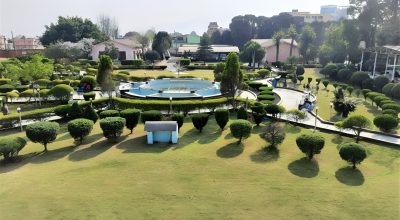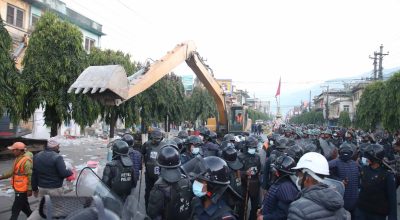
- Rajendra Prasad Paneru/RSS
KANCHANPUR, Dec 12: ‘Denhari’, which has been traditionally used by the Tharu community in the district for storing food grains, is on the verge of disappearance. Denhari are the earthen structures constructed inside the house by using clay, paddy straw and rice husk.
These structures are constructed in various shapes as round, rectangular, conical and others. They can be used for many years once constructed. They formed an integral part of a typical Tharu home.
However, this traditional craft of the indigenous Tharu community is nearing extinction as the younger generation is adopting the modern way of lifestyle and constructing modern houses instead of the traditional ones.

Moreover, this unique craftsmanship of the Tharus is disappearing as the new generation are not interested in it while the older generation people are also not keen to transfer this indigenous skill to them.
The Tharu people say that they are facing problem managing the clay required for making the Denhari. The loamy type of clay for making Denhari has to be brought from the ponds and lakes inside the forest areas.
But these days the forest authorities do not allow the collection and digging of this type of soil inside the forest in the name of forest conservation.
“In the traditional houses, the Denharis were used to demarcate the rooms,” Kali Prasad Chaudhary of Beldandi said, adding,” now-a-days, people have started building modern houses without leaving room for constructing Denharis.”
He expressed concern over the gradual disappearance of this tradition, emphasizing on the need of the older generation people to teach the younger generation people to keep this craft alive.
“These days, people have been opting for bins made of tin, bamboo and plastic for storing food grains.
This is also one reason for the displacement of the Denharis,” Chaudhary said, adding that people do not want to take all the trouble of collecting clay from the forests and constructing the Denhari when they get ready-made bins in the market.
According to him, Denhari is not only the part of the Tharu culture but it also has religious value.
“Denhari has its own religious importance. It is necessary to make the younger generation understand its value,” he said.
Mostly, the women construct the Denhari. Paddy, wheat, rice, maize and other food grains as well as lentils, peas and mustard seeds are stored in the Denharis.
“The food grains kept in Denhari do not decay nor infested with insects,” said Dhan Bahadur Kushmi, adding, “Even the rice without chaff does not rot.” The mud-made granaries can still be seen in array in some houses. However, such storage are gradually vanishing in Tharu community.
The Denhari are of various sizes. Some are cylindrical and some with flat base. Of them, the Pataha Denhari is kept in the room in the western side of house, where, it is believed the God also resides there.
The Tharu community believes that Denhari must not be kept empty. If it is empty, it is a bad omen. Once the Pataha Denhari is broken and destroyed, the food grains stored in it is given to the daughter who is married off.
In addition to rice, salt, pulse is also kept in the mud-made granary. Danheri is an essential thing for storage of food grains in Tharu community.














